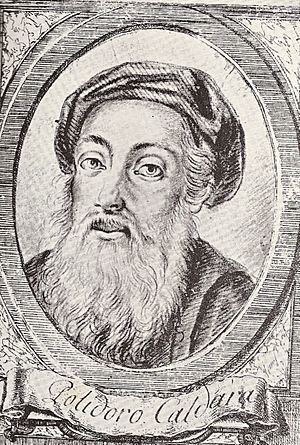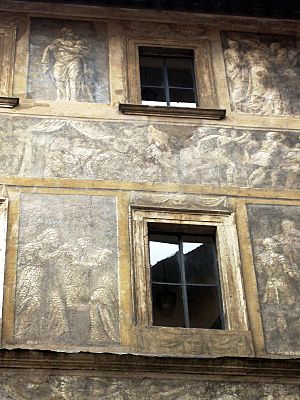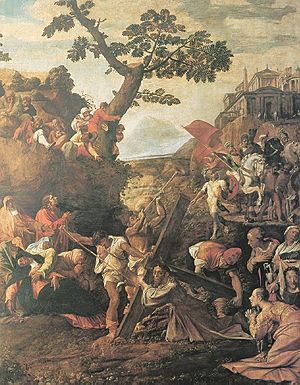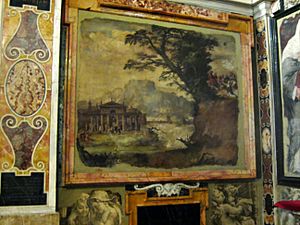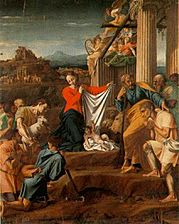Polidoro da Caravaggio facts for kids
Polidoro Caldara, also known as Polidoro da Caravaggio (around 1499 – 1543), was an Italian painter. He lived during the Mannerist period, which was a style of art that came after the Renaissance. Many art experts consider him one of the most talented students of the famous artist Raphael. Polidoro was especially known for his paintings on the outside walls of houses in Rome, though most of these have now disappeared. He is not related to another famous painter named Michelangelo Merisi da Caravaggio, even though both artists came from the same town of Caravaggio.
Contents
Early Life and Artistic Journey
Polidoro Caldara was born in Caravaggio, a town in what is now Lombardy, Italy. When he was young, he worked as a laborer, helping to carry building materials for the Vatican. During this time, he met many artists and caught the eye of Maturino da Firenze. Maturino was one of Raphael's main helpers.
Around 1517, Polidoro joined Raphael's large art workshop. He helped paint the famous Raphael Rooms inside the Vatican. After a while, Polidoro and Maturino decided to work together. They became well-known for painting the outside walls of palaces. They often used a technique called sgraffito, which involves scratching designs into layers of plaster.
Challenges and New Beginnings
In 1527, a big event called the Sack of Rome happened. This was when the army of Charles V attacked and looted the city. Sadly, Maturino was killed during this event. Polidoro had to leave Rome and fled to Naples. From Naples, he moved to Messina, a city in Sicily, where he found great success as an artist.
Polidoro was planning to return to mainland Italy from Messina. However, in 1543, he died tragically. According to historical accounts, he was robbed and killed by one of his own assistants. His tomb in Messina was later destroyed in the late 1500s.
Polidoro's Unique Art Style
Polidoro's most important paintings include a Crucifixion, which he painted in Messina. He also created a Deposition of Christ (1527) and a Christ Carrying the Cross (1530–34). Both of these are now in the Museo di Capodimonte in Naples, which has the best collection of his artwork.
His paintings have a very unique style. They are painted with a lot of freedom and show strong emotions. The Christ Carrying the Cross painting, for example, shows influences from Northern European art. This might be because Sicily, where he worked, had strong connections with countries like the Netherlands.
Lost Masterpieces and Lasting Influence
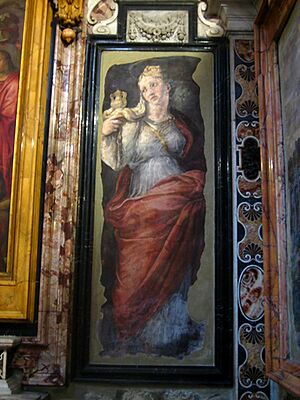
Most of Polidoro's and Maturino's outdoor paintings on palace walls have been lost over time. This is because they were exposed to the weather. However, we know what many of them looked like thanks to copies made by other artists, such as Pietro Santi Bartoli and Cherubino Alberti. These facade decorations often used a technique called grisaille, which means they were painted in shades of gray to look like sculptures.
These outdoor paintings were very famous in their time. They were like a "visual textbook" for young artists who wanted to learn. Polidoro learned from Raphael how to create art inspired by ancient Roman designs. But he added his own cleverness and spirit to his work. There are also many high-quality drawings by Polidoro that still exist today.
A series of nine small wooden panels, which were likely from inside a palace, give us a glimpse of his lively and skilled work. Eight of these panels are now in the English Royal Collection, and one is in the Louvre museum in Paris.
Polidoro's Students
Polidoro had several students in Messina who learned from him. Some of these artists include Deodato Guinaccia, Stefano Giordano, Mariano Riccio, Antonello Riccio, Jacopo Vignerio, and Alfonso Lazzaro.
Gallery
-
Red chalk drawing of the Holy Family.
See also
 In Spanish: Polidoro da Caravaggio para niños
In Spanish: Polidoro da Caravaggio para niños


